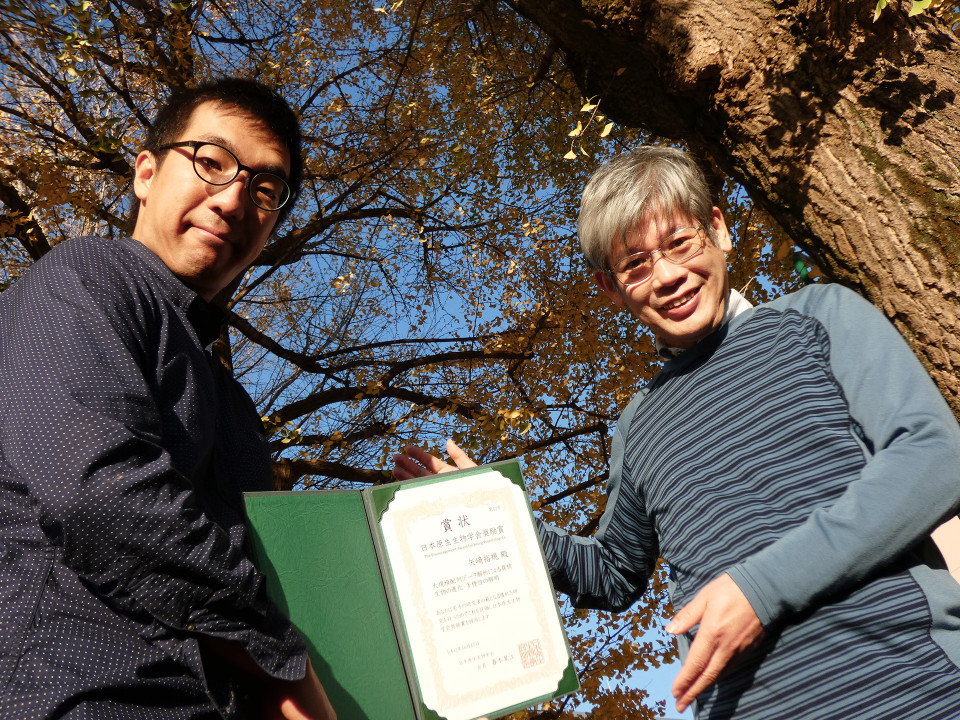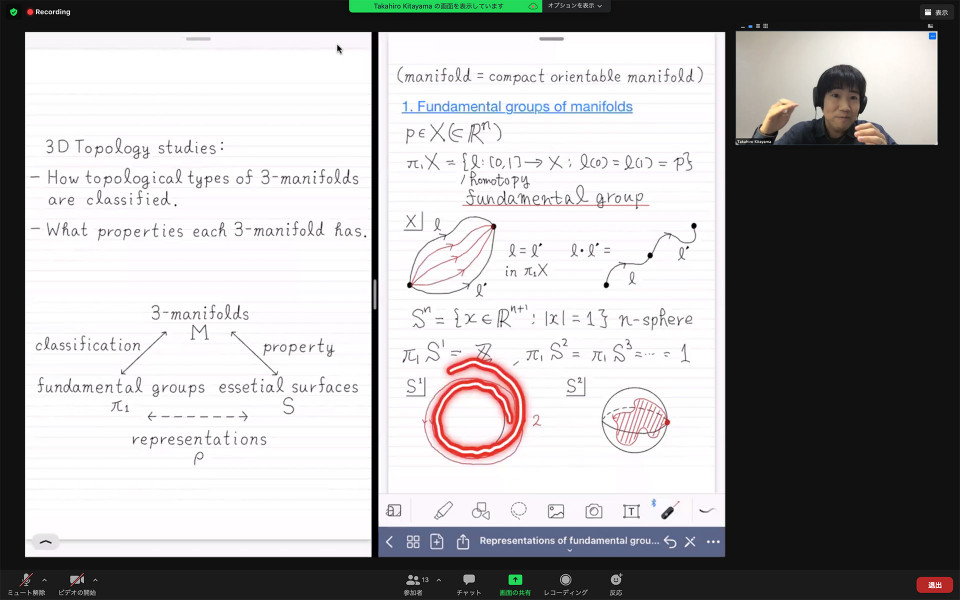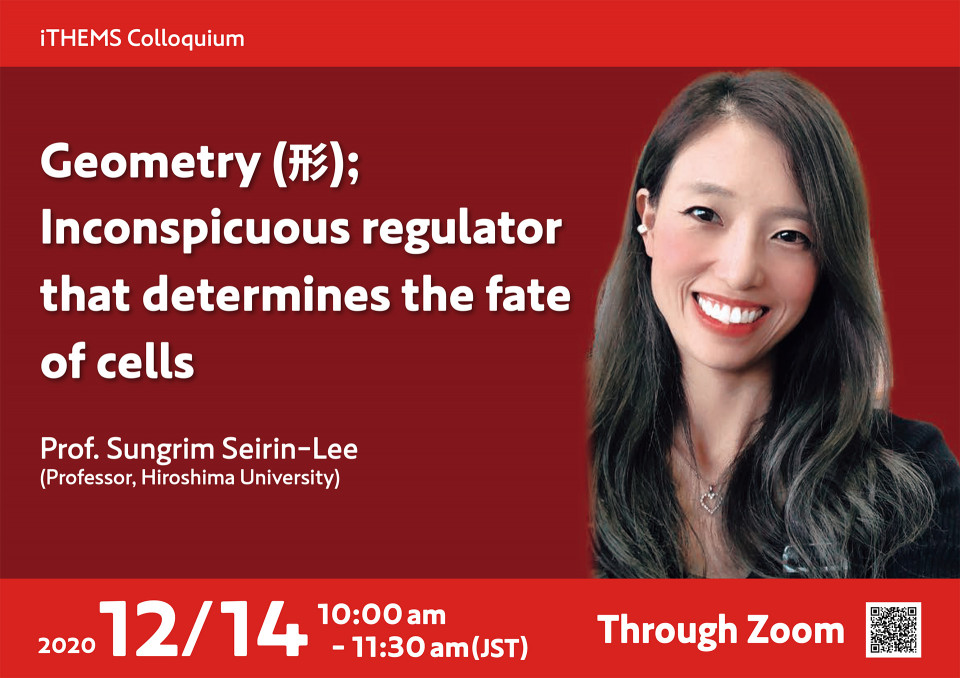Volume 129
Back to Newsletter List
Award
Dr. Euki Yazaki received "2020 The Encouragement Award for Young Protistologists"
2020-11-26
It is our great pleasure to inform you that our iTHEMS colleague, Euki Yazaki received "2020 The Encouragement Award for Young Protistologists" (日本原生生物学会奨励賞) from "Japan Society of Protistology (日本原生生物学会) for "Revealing of the evolution and diversity of eukaryotes through large-scale sequence data analyses" (大規模配列データ解析による真核生物の進化・多様性の解明). The award ceremony was held at Japan Society of Protistology Meeting on Nov.22-23, 2020. Many congratulations, Euki !
Seminar Report
Math Seminar by Dr. Takahiro Kitayama on November 16, 2020
2020-11-24
On November 16, professor Takahiro Kitayama from University of Tokyo gave a talk entitled “Representations of fundamental groups and 3-manifold topology” at the iTHEMS math seminar.
In the first part, he introduced a central motivation of 3-manifold topology: classify all 3-manifolds up to diffeomorphisms. As one of the important tools, he introduced the fundamental groups of spaces. He reviewed several known results of the fundamental groups of manifolds. Next, he focused on essential surfaces and introduced Haken 3-manifolds as an important class of 3-manifolds. In particular, he introduced several examples of Haken and non-Haken manifolds. At the end of the first talk, he explained SL(2,C)-representation spaces (character varieties) of the fundamental groups of 3-manifolds. He mentioned that the representation space has been used as a fundamental tool to classify knots and 3-manifolds.
In the second part, he first mentioned Culler-Shalen, Morgan-Shalen’s theorem which says that an ideal point of the SL(2,C)-character variety of a given 3-manifold M gives an essential surface of M. Friedl, Hara, Kitayama, and Nagel developed C-S and M-S’s theory for the Lie group SL(n,C). He explained the main idea to obtain all essential surfaces from ideal points of SL(n,C)-character variety. In particular, he introduced the tautological representation depending on some affine curve of the SL(2,C)-character variety, and an action of the fundamental group on some contractible simplicial complex called the Bruhat-Tits building. Then by a standard argument of topology, he constructed some simplicial map f from the universal covering space of a given 3-manifold to the Bruhat-Tits building. By taking the inverse image of f(after ignoring trivial parts and dividing by the fundamental group of the 3-manifold), he finally constructed an essential surface. Next, he also told us about a relation between (homotopy types of) boundary loops of essential surfaces of knot complements and slopes of sides of the Newton polygon obtained from A-polynomials. He said an essential idea of the result, which can detect whether the boundary of an essential surface obtained from an ideal point is boundary parallel or not. At the end of the second talk, as the leading coefficients of torsion functions, he gave a function c_{M, ψ} on the SL(n, C)-character variety. After explaining Dunfield-Friedl-Jackson’s conjecture, he gave a partial solution of the conjecture which is related to the finiteness of c_{M, ψ} on the ideal points.
Representations of fundamental groups and 3-manifold topology
November 16 (Mon) 16:00 - 18:10, 2020
Upcoming Events
Seminar
iTHEMS Math Seminar
Flat and spherical surface approximations
November 30 (Mon) 16:00 - 17:30, 2020
Martin Skrodzki (Visiting Scientist, RIKEN Interdisciplinary Theoretical and Mathematical Sciences Program (iTHEMS) / Fellow, German Academic Scholarship Foundation, Germany)
State-of-the-art acquisition devices produce surface representations of increasingly high resolution. While these detailed representations are important for production, they are problematic e.g. when exchanging drafts via the internet or when a quick rendering for comparison is necessary. In the first part of the talk, I will present results and further research questions from a paper I recently co-authored on 'Variational Shape Approximation'. This approach aims at linearizing the input surface and representing it via a set of localized planar segments. In the second part of the talk, I will present some ongoing research on surface representations via balls. This work started with constructions from spherical neodym magnets and provided a set of mathematical questions. These investigations are joint work with FU Berlin and OIST.
Venue: via Zoom
Event Official Language: English
Seminar
DMWG Seminar
Directional dark matter search and the technologies
December 3 (Thu) 10:00 - 11:00, 2020
Tatsuhiro Naka (Lecturer, Department of Physics, Toho University / Specially Appointed Assistant Professor, Kobayashi-Maskawa Institute for the Origin of Particles and the Universe (KMI), Nagoya University)
For identification of the dark matter, various methodologies are required. Especially, the direct detection is one of the most important goals to directly understand itself. Now, there are various technologies for direct detection, but almost all detectors have no direction sensitivity. We can obtain essential information such as dependence of motion between the earth and the dark matter, velocity distribution and background from direction information, therefore that becomes a very important methodology to identify the dark matter for future as long as we consider "particle dark matter". In this seminar, I report about the potential of direction sensitive dark matter search and current experimental effort.
Venue: via Zoom
Event Official Language: English
Seminar
iTHEMS Theoretical Physics Seminar
KPZ equation, attractive bosons, and the Efimov effect
December 3 (Thu) 13:00 - 14:30, 2020
Yusuke Nishida (Associate Professor, Department of Physics, Tokyo Institute of Technology)
The Kardar-Parisi-Zhang (KPZ) equation for surface growth has been a paradigmatic model in nonequilibrium statistical physics. In particular, it in dimensions higher than two undergoes a roughening transition from smooth to rough phases with increasing the nonlinearity. It is also known that the KPZ equation can be mapped onto quantum mechanics of attractive bosons with a contact interaction, where the roughening transition corresponds to a binding transition of two bosons with increasing the attraction. Such critical bosons in three dimensions actually exhibit the Efimov effect, where a three-boson coupling turns out to be relevant under the renormalization group so as to break the scale invariance down to discrete one. On the basis of these facts linking the two distinct subjects in physics, we predict that the KPZ roughening transition in three dimensions shows either the discrete scale invariance or no intrinsic scale invariance.
Venue: via Zoom
Event Official Language: English
Lecture
Academic-Industrial Innovation LectureCo-hosted by RIKEN SUURI CORPORATION
Toward the Practical Use of Quantum Computers
December 4 (Fri) 10:30 - 12:00, 2020
Shunji Matsuura (Visiting Scientist, RIKEN Interdisciplinary Theoretical and Mathematical Sciences Program (iTHEMS) / Fundamental Researcher, Quantum Simulation Division, 1QBit, Canada)
量子コンピュータは古典コンピュータとは異なる原理に基づいて動いており、自然科学を含む様々な分野において大きな変化をもたらすと考えられている。特にこの数年の進展は著しく、量子計算の古典計算に対する優位性が実験的に初めて示されるなど、期待されているマイルストーンが着実に達成されていっている。一方で量子コンピュータの発展において常に障害となっているのがノイズである。量子状態はノイズの影響を受けやすく、現在の量子コンピュータにおいては量子ゲート操作を行うごとに状態の精度が減衰していってしまう。そのため、量子コンピュータにかける負担をできるだけ減らすようなアルゴリズムの開発や、計算結果からエラーを取り除く方法、観測回数をできるだけ減らす方法等、様々な研究が行われている。本講義ではこれら量子コンピュータの実用化に向けた最近の研究と今後の課題について話す。
Venue: via Zoom
Event Official Language: Japanese
External Event
Sponsored by academistSupported by RIKEN SUURI CORPORATION
Presented by iTHEMS & academist - Do you really know what the black hole is?
December 6 (Sun) 14:00 - 16:00, 2020
Shigehiro Nagataki (Deputy Program Director, RIKEN Interdisciplinary Theoretical and Mathematical Sciences Program (iTHEMS) / Chief Scientist, Astrophysical Big Bang Laboratory, RIKEN Cluster for Pioneering Research (CPR))
Yoshiyuki Inoue (Senior Visiting Scientist, RIKEN Interdisciplinary Theoretical and Mathematical Sciences Program (iTHEMS) / Associate Professor, Department of Earth and Space Science, Graduate School of Science, Osaka University)
Yuki Yokokura (Senior Research Scientist, RIKEN Interdisciplinary Theoretical and Mathematical Sciences Program (iTHEMS))
–From the latest theories and observations to the explanation of the Nobel Prize in Physics! An introduction to black holes from active physicists–
The 2020 Nobel Prize in Physics was awarded to Sir Roger Penrose, Prof. Dr. Reinhard Genzel and Prof. Andrea Ghez for their contributions to the theory and observation of black holes. Black holes have continued to provide hot topics in recent years, such as gravitational waves from black hole coalescence and black hole imaging, but do you really know what black holes are? Three cutting-edge black hole researchers will explain its identity and mystery.
Venue: via Online
Event Official Language: Japanese
Seminar
iTHEMS Math Seminar
Scattering theory for half-line Schrödinger operators: analytic and topological results
December 7 (Mon) 16:00 - 18:10, 2020
Hideki Inoue (Nagoya University)
Levinson’s theorem is a surprising result in quantum scattering theory, which relates the number of bound states and the scattering part of the underlying quantum system. For the last about ten years, it has been proved for several models that once recast in an operator algebraic framework this relation can be understood as an index theorem for the Møller wave operators. Resulting index theorems are called topological version of Levinson’s theorem or shortly topological Levinson’s theorem. In this talk, we first review the background and the framework of our investigation. New analytical and topological results are provided for Schrödinger operators on the half-line. This talk is based on my Ph.D thesis.
Venue: via Zoom
Event Official Language: English
Colloquium
iTHEMS Colloquium
Geometry (形); Inconspicuous regulator that determines the fate of cells
December 14 (Mon) 10:00 - 11:30, 2020
Sungrim Seirin-Lee (Professor, Hiroshima University)
December 14 at 10:00-11:30, 2020 (JST)
December 13 at 20:00-21:30, 2020 (EST)
In the history of mathematical study in pattern formation, the effect of domain has been considered as an important factor that can regulate spatial patterning. However, it is still unknown in biology how the geometry of the domain such as nuclear or cellular shapes can directly regulate the cell fate. In this talk, I will introduce two studies of spatial reorganization in chromatin and cellular dynamics and show that the domain is likely to play a critical role in determining the cell function.
Venue: via Zoom
Event Official Language: English
Paper of the Week
Week 4 of November
2020-11-26
Title: Motives with modulus, III: The categories of motives
Author: Bruno Kahn, Hiroyasu Miyazaki, Shuji Saito, Takao Yamazaki
arXiv: http://arxiv.org/abs/2011.11859v1
Title: Scale setting the M{ö}bius Domain Wall Fermion on gradient-flowed HISQ action using the omega baryon mass and the gradient-flow scale w0
Author: Nolan Miller, Logan C Carpenter, Evan Berkowitz, Chia Cheng Chang, Ben Hörz, Dean Howarth, Henry Monge-Camacho, Enrico Rinaldi, David A. Brantley, Christopher Körber, Chris Bouchard, M. A. Clark, Arjun Singh Gambhir, Christopher J. Monahan, Amy Nicholson, Pavlos Vranas, André Walker-Loud
arXiv: http://arxiv.org/abs/2011.12166v1
Title: The Julia Line of a Riemann-Type Functional Equation {\footnotesize -- Counting Formulae, Dirichlet Polynomial Approximations, and a Weak Gram Law --}
Author: Athanasios Sourmelidis, Jörn Steuding, Ade Irma Suriajaya
arXiv: http://arxiv.org/abs/2011.10692v1
Title: Thermalization of Yang-Mills theory in a (3+1) dimensional small lattice system
Author: Tomoya Hayata, Yoshimasa Hidaka
arXiv: http://arxiv.org/abs/2011.09814v1
Title: Replica wormholes for an evaporating 2D black hole
Author: Kanato Goto, Thomas Hartman, Amirhossein Tajdini
arXiv: http://arxiv.org/abs/2011.09043v1
If you would like to cancel your subscription or change your email address,
please let us know via our contact form.
Copyright © iTHEMS, RIKEN. All rights reserved.







